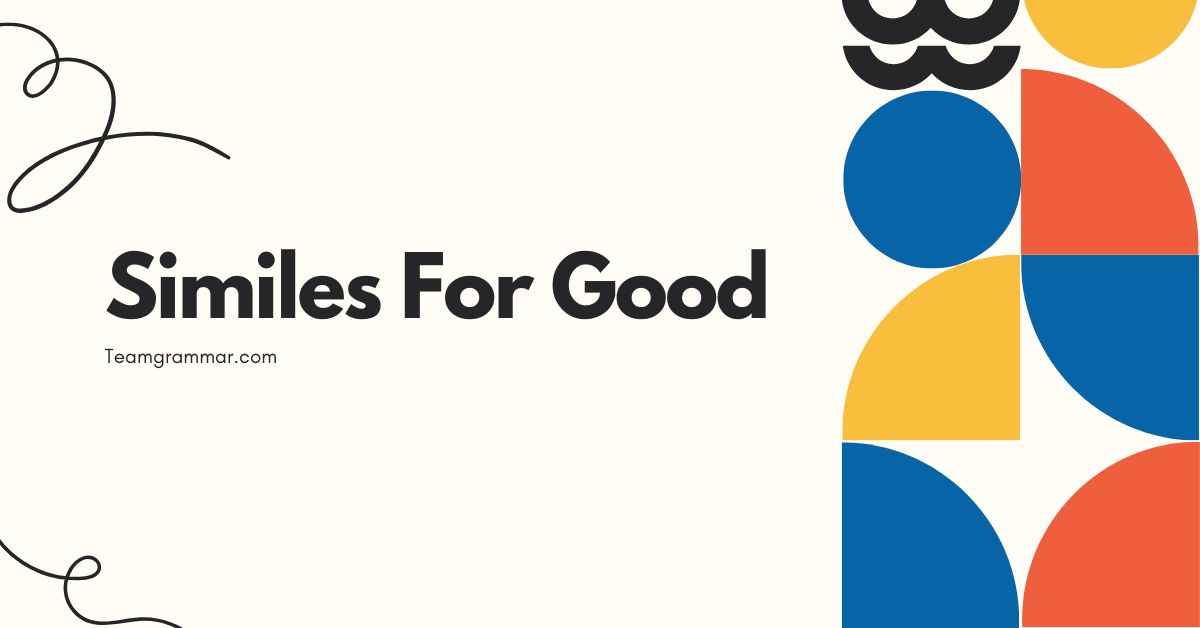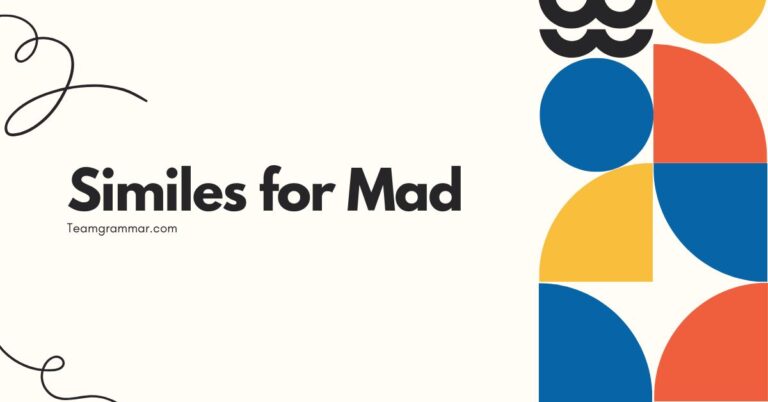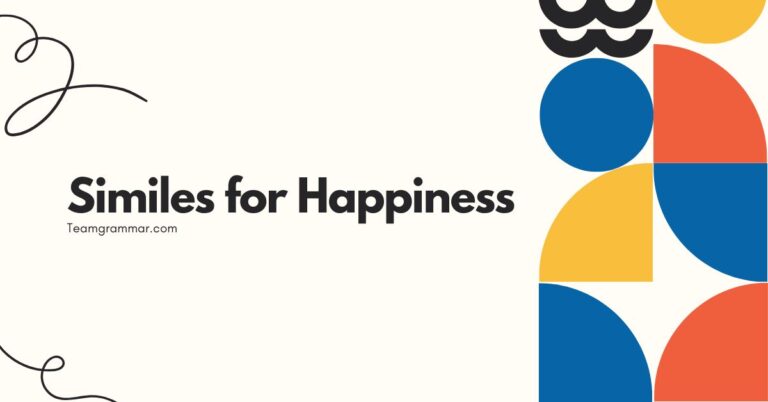47 Similes For Good: Mastering Comparisons in English Grammar
Similes are powerful tools in the English language, allowing us to create vivid and engaging descriptions by comparing one thing to another. Understanding similes is crucial for both improving comprehension and enhancing writing skills.
This article offers a comprehensive guide to similes, exploring their definition, structure, types, usage rules, and common mistakes. Whether you’re a student learning the basics or an advanced writer seeking to refine your style, this guide provides valuable insights and practical exercises to master the art of using similes effectively.
By delving into the intricacies of similes, you’ll not only enrich your vocabulary but also gain a deeper appreciation for the nuances of figurative language. This knowledge will enable you to express yourself with greater clarity, creativity, and impact.
Get ready to embark on a journey that will transform your understanding of similes and elevate your command of the English language.
Table of Contents
- Definition of Similes
- Structural Breakdown of Similes
- Types or Categories of Similes
- Examples of Similes
- Usage Rules for Similes
- Common Mistakes with Similes
- Practice Exercises
- Advanced Topics in Similes
- FAQ About Similes
- Conclusion
Definition of Similes
A simile is a figure of speech that directly compares two different things using the words “like” or “as.” The purpose of a simile is to create a vivid image or convey a specific quality by associating it with something familiar. Similes are fundamental to descriptive writing, enhancing its impact and making it more engaging for the reader.
Similes belong to the broader category of figurative language, which also includes metaphors, personification, and hyperbole. Unlike metaphors, which state that something *is* something else, similes only suggest a resemblance or similarity between two things.
This distinction is crucial in understanding the function and impact of similes in writing.
The main function of a simile is to provide clarity and emphasis. By comparing something abstract or unfamiliar to something concrete and well-known, a simile helps the reader understand the subject more easily.
Additionally, similes can add emotional depth and create a stronger connection between the writer and the audience. They are commonly used in literature, poetry, everyday speech, and advertising to make language more expressive and memorable.
Structural Breakdown of Similes
The basic structure of a simile consists of three key elements: the subject, the comparison word (either “like” or “as”), and the object of comparison. Understanding the relationship between these elements is essential for constructing effective and meaningful similes.
Thesubjectis the thing being described or compared. It can be a person, object, idea, or situation.
Thecomparison word(“like” or “as”) serves as the bridge between the subject and the object of comparison, indicating that a similarity exists. Theobject of comparisonis the thing to which the subject is being compared.
It should be something that shares a quality or characteristic with the subject, making the comparison relevant and understandable.
For example, in the simile “The warrior was as brave as a lion,” the subject is “the warrior,” the comparison word is “as,” and the object of comparison is “a lion.” The simile suggests that the warrior possesses the quality of bravery, which is commonly associated with lions. The placement of these elements is generally consistent, although variations can occur for stylistic effect.
The effectiveness of a simile depends on the strength and clarity of the comparison. A well-constructed simile should create a clear and memorable image in the reader’s mind, enhancing their understanding and appreciation of the subject.
The comparison should also be logical and relevant, avoiding comparisons that are too obscure or confusing.
Types or Categories of Similes
Similes can be categorized based on the type of comparison they make and the effect they create. Understanding these categories can help writers choose the most appropriate simile for their intended purpose.
Descriptive Similes
Descriptive similes focus on providing vivid and detailed descriptions of the subject. They often use sensory language to create a strong impression in the reader’s mind.
For example, “The sky was as blue as a sapphire” uses the color of a sapphire to describe the sky, creating a visual image.
Explanatory Similes
Explanatory similes aim to clarify or explain something by comparing it to something more familiar or understandable. They are often used to simplify complex concepts or ideas.
For example, “The process was like building a house, one step at a time” explains the process by comparing it to the familiar task of building a house.
Emphatic Similes
Emphatic similes are used to emphasize a particular quality or characteristic of the subject. They often use strong or exaggerated comparisons to make a point.
For example, “He was as stubborn as a mule” emphasizes the person’s stubbornness by comparing it to the well-known stubbornness of a mule.
Humorous Similes
Humorous similes are used to create a comedic effect by making unexpected or absurd comparisons. They often rely on irony or exaggeration to elicit laughter.
For example, “He was as useful as a screen door on a submarine” creates humor by comparing the person’s usefulness to something completely useless.
Negative Similes
Negative similes emphasize what something is *not* like, often to highlight its unique qualities or to deny a common association. For example, “She is not as naive as she seems” uses a simile to negate an assumption about the subject’s naivety.
Examples of Similes
The following tables provide a variety of examples of similes, categorized by their function and the type of comparison they make. These examples illustrate the versatility and effectiveness of similes in descriptive writing.
Table 1: Descriptive Similes
This table includes similes that focus on providing vivid and detailed descriptions, using sensory language to create strong impressions.
| Simile | Explanation |
|---|---|
| The snow was as white as a blank canvas. | Describes the color of the snow using a visual comparison. |
| Her voice was as smooth as silk. | Describes the texture of her voice, creating an auditory image. |
| The coffee was as bitter as disappointment. | Describes the taste of the coffee, evoking an emotional association. |
| The air was as thick as pea soup. | Describes the density of the air, creating a sensory experience. |
| His eyes were as cold as ice. | Describes the emotion conveyed by his eyes. |
| The night was as dark as coal. | Describes the darkness of the night using a visual comparison. |
| The music was as loud as thunder. | Describes the volume of the music, creating an auditory image. |
| Her skin was as soft as velvet. | Describes the texture of her skin, creating a tactile sensation. |
| The dessert was as sweet as honey. | Describes the taste of the dessert, evoking a sense of pleasure. |
| The wind was as sharp as a knife. | Describes the feeling of the wind, creating a sensory experience. |
| The stars were like diamonds in the sky. | Describes the appearance of the stars. |
| The ocean was as vast as the imagination. | Describes the size of the ocean. |
| His smile was as bright as the sun. | Describes the radiance of his smile. |
| The silence was like a heavy blanket. | Describes the feeling of the silence. |
| The flowers were as colorful as a rainbow. | Describes the variety of colors in the flowers. |
| The rain fell like tears from the sky. | Describes the way the rain fell. |
| The city was as busy as a beehive. | Describes the level of activity in the city. |
| The moon was as round as a plate. | Describes the shape of the moon. |
| The grass was as green as emerald. | Describes the color of the grass. |
| The river flowed like a ribbon through the valley. | Describes the movement of the river. |
| The cake was as light as a feather. | Describes the texture of the cake. |
| Her laughter was like music to his ears. | Describes the pleasant sound of her laughter. |
| The fog was as thick as cotton. | Describes the density of the fog. |
| His anger was as fiery as a volcano. | Describes the intensity of his anger. |
| The leaves were as red as rubies. | Describes the color of the leaves. |
| The snow fell as silently as feathers. | Describes the sound of the falling snow. |
| The bread was as hard as a rock. | Describes the texture of the bread. |
| The soup was as hot as lava. | Describes the temperature of the soup. |
Table 2: Explanatory Similes
This table includes similes that aim to clarify or explain something by comparing it to something more familiar or understandable.
| Simile | Explanation |
|---|---|
| Learning a new language is like climbing a mountain. | Explains the difficulty and effort involved in learning a new language. |
| Life is like a box of chocolates, you never know what you’re going to get. | Explains the unpredictability of life. |
| The internet is like a vast library, full of information. | Explains the scope and nature of the internet. |
| Marriage is like a garden, it requires constant care and attention. | Explains the responsibilities involved in maintaining a marriage. |
| Parenting is like juggling, you have to keep many things in the air at once. | Explains the multitasking required in parenting. |
| Investing is like planting seeds, you have to wait for them to grow. | Explains the patience required in investing. |
| Writing a book is like building a house, it requires planning and effort. | Explains the process of writing a book. |
| Friendship is like a plant, it needs nurturing to thrive. | Explains the importance of maintaining friendships. |
| Forgiveness is like unlocking a cage, freeing yourself from resentment. | Explains the benefits of forgiveness. |
| Change is like the seasons, it is inevitable and cyclical. | Explains the nature of change. |
| Communication is like a bridge, connecting people together. | Explains the function of communication. |
| Education is like a ladder, helping you climb to new heights. | Explains the benefits of education. |
| Teamwork is like a symphony, each instrument playing its part. | Explains the importance of collaboration. |
| Success is like a journey, not a destination. | Explains the process-oriented nature of success. |
| Leadership is like steering a ship, guiding others towards a goal. | Explains the role of a leader. |
| Creativity is like a muscle, it gets stronger with practice. | Explains how to improve creativity. |
| Problem-solving is like detective work, uncovering clues to find a solution. | Explains the process of solving problems. |
| Time is like a river, constantly flowing and never stopping. | Explains the continuous nature of time. |
| Learning is like adding pieces to a puzzle, creating a complete picture. | Explains the process of learning. |
| Stress is like a pressure cooker, it can explode if not managed. | Explains the dangers of unmanaged stress. |
| Healing is like mending a broken bone, it takes time and care. | Explains the process of healing. |
| Growth is like a tree, reaching for the sky. | Explains the upward nature of growth. |
| Hope is like a light, guiding you through darkness. | Explains the importance of hope. |
| Memory is like a photograph, capturing moments in time. | Explains the function of memory. |
| Dreams are like stars, guiding you towards your goals. | Explains the inspirational nature of dreams. |
| Grief is like a wave, it comes and goes in intensity. | Explains the fluctuating nature of grief. |
| Habits are like roots, they grow deeper over time. | Explains the difficulty of breaking habits. |
| Belief is like a foundation, supporting your actions and decisions. | Explains the importance of belief. |
Table 3: Emphatic Similes
This table includes similes that are used to emphasize a particular quality or characteristic of the subject, often using strong or exaggerated comparisons.
| Simile | Explanation |
|---|---|
| He was as strong as an ox. | Emphasizes his physical strength. |
| She was as quick as a cheetah. | Emphasizes her speed. |
| The pain was as intense as burning fire. | Emphasizes the severity of the pain. |
| He was as brave as a lion. | Emphasizes his courage. |
| She was as stubborn as a mule. | Emphasizes her unwillingness to change her mind. |
| The task was as difficult as climbing Mount Everest. | Emphasizes the challenge of the task. |
| He was as hungry as a wolf. | Emphasizes his extreme hunger. |
| She was as angry as a hornet. | Emphasizes her intense anger. |
| The cold was as bitter as ice. | Emphasizes the extreme cold. |
| He was as determined as a bulldog. | Emphasizes his unwavering determination. |
| She was as graceful as a swan. | Emphasizes her elegance and poise. |
| The noise was as deafening as a jet engine. | Emphasizes the loudness of the noise. |
| He was as patient as a saint. | Emphasizes his extraordinary patience. |
| She was as wise as an owl. | Emphasizes her intelligence and knowledge. |
| The pressure was as crushing as an avalanche. | Emphasizes the overwhelming pressure. |
| He was as gentle as a lamb. | Emphasizes his kindness and tenderness. |
| She was as radiant as the sun. | Emphasizes her beauty and glow. |
| The fear was as paralyzing as a nightmare. | Emphasizes the intensity of the fear. |
| He was as dedicated as a soldier. | Emphasizes his commitment and loyalty. |
| She was as resilient as a rubber band. | Emphasizes her ability to bounce back from adversity. |
| The heat was as unbearable as a desert sun. | Emphasizes the extreme heat. |
| He was as meticulous as a surgeon. | Emphasizes his attention to detail. |
| She was as vigilant as a hawk. | Emphasizes her watchfulness. |
| The disappointment was as profound as a deep wound. | Emphasizes the depth of the disappointment. |
| He was as relentless as a storm. | Emphasizes his persistence and force. |
| She was as adaptable as a chameleon. | Emphasizes her ability to change and adjust. |
| The challenge was as daunting as a mountain range. | Emphasizes the magnitude of the challenge. |
| He was as dependable as the sunrise. | Emphasizes his reliability. |
Usage Rules for Similes
Using similes effectively requires understanding the rules that govern their construction and application. These rules ensure that similes are clear, meaningful, and appropriate for the context in which they are used.
Clarity and Relevance
A simile should be clear and easy to understand. The comparison should be relevant and logical, avoiding comparisons that are too obscure or confusing.
The reader should be able to easily see the connection between the subject and the object of comparison.
Originality and Freshness
Overused or cliché similes can weaken your writing. Strive for originality by creating fresh and imaginative comparisons that will capture the reader’s attention.
Avoid common similes such as “as busy as a bee” or “as quiet as a mouse.”
Consistency and Tone
The tone of your similes should be consistent with the overall tone of your writing. Avoid using humorous similes in a serious context, or vice versa.
The simile should enhance the mood and atmosphere of the piece, not detract from it.
Appropriateness and Sensitivity
Be mindful of the cultural and social implications of your similes. Avoid using comparisons that could be offensive, insensitive, or discriminatory.
Consider your audience and the potential impact of your language.
Conciseness and Brevity
Similes should be concise and to the point. Avoid overly long or complex similes that can distract from the main idea.
The comparison should be clear and memorable, without being overly elaborate.
Use of “Like” vs. “As”
While both “like” and “as” are used to create similes, there are subtle differences in their usage. “Like” is generally used to compare nouns or pronouns, while “as” is used to compare clauses or phrases.
However, this distinction is not always strictly followed, and both words can often be used interchangeably.
Example using “like”: “He runs like the wind.” (compares a noun phrase to another noun phrase)
Example using “as”: “She sings as beautifully as an angel.” (compares two clauses)
Common Mistakes with Similes
Even experienced writers can make mistakes when using similes. Being aware of these common errors can help you avoid them and improve the quality of your writing.
Using Cliché Similes
Incorrect: He was as busy as a bee.
Correct: He was working tirelessly, like a machine that never stops.
Creating Illogical Comparisons
Incorrect: The car was as happy as a tree.
Correct: The car was as shiny as a new penny.
Using Mixed Metaphors and Similes
Incorrect: He was as strong as an ox, but his ideas were a house of cards.
Correct: He was as strong as an ox, but his ideas were fragile.
Overusing Similes
Incorrect:The day was as bright as the sun. The birds were singing like angels.
The flowers were as colorful as a rainbow.Correct:The bright day was filled with the cheerful songs of birds and the vibrant colors of blooming flowers.
Misusing “Like” and “As”
Incorrect: She sings like she is an angel.
Correct: She sings as beautifully as an angel.
Using Inappropriate Similes
Incorrect: The funeral was as fun as a party.
Correct: The funeral was as somber as a cloudy day.
Confusing Similes with Metaphors
It’s a common mistake to confuse similes with metaphors. Remember, similes use “like” or “as” to make a comparison, while metaphors directly state that something *is* something else.
For example:
Simile: “Her smile was like sunshine.”
Metaphor: “Her smile was sunshine.”
Practice Exercises
The following exercises will help you practice using similes effectively. Try to create original and imaginative comparisons that are clear, relevant, and appropriate for the context.
Exercise 1: Complete the Simile
Complete the following similes by adding an appropriate object of comparison.
| Question | Answer |
|---|---|
| 1. The music was as loud as ______. | The music was as loud as a rock concert. |
| 2. Her skin was as soft as ______. | Her skin was as soft as a baby’s cheek. |
| 3. The coffee was as bitter as ______. | The coffee was as bitter as unsweetened chocolate. |
| 4. He ran as fast as ______. | He ran as fast as a race car. |
| 5. The snow was as white as ______. | The snow was as white as freshly fallen snow. |
| 6. The exam was as hard as _______. | The exam was as hard as trying to solve a Rubik’s Cube blindfolded. |
| 7. The news hit him like _______. | The news hit him like a ton of bricks. |
| 8. She was as graceful as _______. | She was as graceful as a ballerina. |
| 9. The river was flowing as smoothly as _______. | The river was flowing as smoothly as silk. |
| 10. The child slept like _______. | The child slept like a log. |
Exercise 2: Create Your Own Similes
Create similes to describe the following subjects.
| Subject | Simile |
|---|---|
| 1. A crowded room | A crowded room is like a can of sardines, packed tightly with people. |
| 2. A rainy day | A rainy day is like a melancholic song, filled with a sense of longing. |
| 3. A delicious meal | A delicious meal is like a warm hug, comforting and satisfying. |
| 4. A difficult decision | A difficult decision is like navigating a maze, full of twists and turns. |
| 5. A strong friendship | A strong friendship is like a sturdy bridge, connecting two souls across any distance. |
| 6. A challenging workout | A challenging workout is like climbing a steep hill, pushing you to your limits. |
| 7. A beautiful sunset | A beautiful sunset is like a painter’s masterpiece, blending vibrant colors across the sky. |
| 8. A funny movie | A funny movie is like a tickle fight, bringing laughter and joy. |
| 9. A peaceful forest | A peaceful forest is like a quiet sanctuary, offering solace and tranquility. |
| 10. A difficult boss | A difficult boss is like walking on eggshells, always afraid to make a mistake. |
Exercise 3: Identify the Type of Simile
Identify the type of simile used in each of the following sentences (Descriptive, Explanatory, Emphatic, Humorous, or Negative).
| Question | Answer |
|---|---|
| 1. He was as hungry as a bear after hibernation. | Emphatic |
| 2. Learning to code is like learning a new language. | Explanatory |
| 3. The sky was as blue as a robin’s egg. | Descriptive |
| 4. Trying to argue with him was like wrestling a pig in mud. | Humorous |
| 5. She is not as innocent as she looks. | Negative |
| 6. The cake was as light as air. | Descriptive |
| 7. His anger was as explosive as a volcano. | Emphatic |
| 8. Life is like a roller coaster, full of ups and downs. | Explanatory |
| 9. He was as clumsy as a newborn giraffe. | Humorous |
| 10. The idea didn’t sound as crazy as it initially seemed. | Negative |
Advanced Topics in Similes
For advanced learners, exploring more complex aspects of similes can further enhance their writing skills. This includes understanding extended similes, using similes in different genres, and analyzing the cultural context of similes.
Extended Similes
An extended simile is a simile that is developed over several lines or paragraphs, providing a more detailed and elaborate comparison. This technique allows writers to create a richer and more immersive experience for the reader.
Extended similes are often used in poetry and prose to create vivid imagery and convey complex ideas.
Example:”The mind is like a vast ocean, full of unexplored depths and hidden treasures. It can be calm and serene, reflecting the beauty of the world around it.
But it can also be turbulent and stormy, churning with conflicting emotions and unresolved conflicts. Like the ocean, the mind is constantly changing and evolving, shaped by the forces of experience and the currents of thought.”
Similes in Different Genres
The use of similes can vary depending on the genre of writing. In poetry, similes are often used to create lyrical and evocative imagery.
In fiction, similes can be used to develop characters, describe settings, and advance the plot. In non-fiction, similes can be used to explain complex concepts and make arguments more persuasive.
Understanding the conventions of different genres can help writers use similes more effectively.
Cultural Context of Similes
The meaning and impact of similes can be influenced by cultural context. Some comparisons may be more familiar or relevant to certain cultures than others.
It is important to be aware of these cultural nuances when using similes, especially when writing for a diverse audience. Using culturally appropriate similes can enhance the clarity and effectiveness of your writing.
FAQ About Similes
Here are some frequently asked questions about similes, along with detailed answers to help you deepen your understanding of this important figure of speech.
- What is the difference between a simile and a metaphor?
A simile is a comparison using “like” or “as,” while a metaphor states that one thing *is* another. Similes suggest a resemblance, while metaphors assert an identity. For example, “He is as brave as a lion” (simile) vs. “He is a lion” (metaphor).
- Can a simile be too obvious or cliché?
Yes, overused similes can weaken your writing by lacking originality. Strive for fresh, imaginative comparisons. Instead of “as busy as a bee,” try “as engrossed as a programmer debugging code.”
- How can I make my similes more creative?
Think outside the box! Consider unexpected comparisons that highlight unique aspects of the subject. Use sensory details to engage the reader’s imagination and create vivid images. For example, instead of “as cold as ice,” try “as cold as a forgotten winter promise.”
- Is it okay to use similes in formal writing?
Yes, similes can be used in formal writing, but with caution. Ensure they are appropriate for the tone and audience. Avoid overly colloquial or humorous similes in academic or professional contexts. Choose comparisons that enhance clarity and understanding.
- How many similes should I use in a piece of writing?
There’s no fixed rule, but moderation is key. Overusing similes can make your writing feel forced or artificial. Use them strategically to emphasize key points and create memorable images, but avoid cluttering your prose with too many comparisons.
- What if I can’t think of a good simile?
Don’t force it! Sometimes, a direct description is more effective than a weak or strained simile. Consider focusing on strong verbs and concrete nouns to create vivid imagery without relying on comparisons. You can also try brainstorming with a friend or colleague to generate ideas.
- Can similes be used in spoken language?
Absolutely! Similes are commonly used in everyday speech to make descriptions more engaging and expressive. They can add color and humor to conversations, making them more memorable. However, as in writing, be mindful of the context and audience.
- How important is the object of comparison in a simile?
The object of comparison is crucial because it’s what clarifies and emphasizes the subject’s qualities. Choose objects that have strong, clear associations with the characteristic you want to highlight. A well-chosen object can make the simile more powerful and memorable.
Conclusion
Mastering similes is an essential step in becoming a skilled writer and communicator. By understanding their definition, structure, types, usage rules, and common mistakes, you can use similes effectively to enhance your writing and make it more engaging for your audience.
Remember to strive for clarity, originality, and appropriateness in your comparisons, and to avoid overusing or misusing similes.
As you continue to practice and experiment with similes, you will develop your own unique style and voice. Pay attention to the similes used by other writers and speakers, and analyze how they create different effects.
With time and effort, you will become proficient in the art of using similes to express yourself with greater clarity, creativity, and impact. Embrace the power of comparison, and let your imagination soar!







